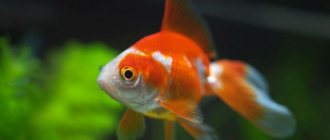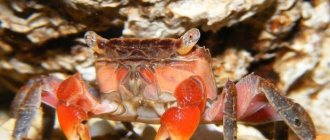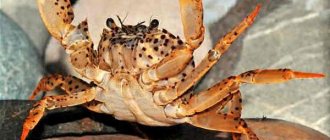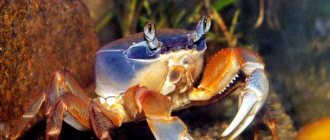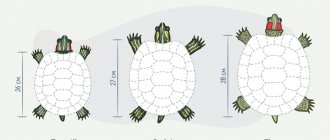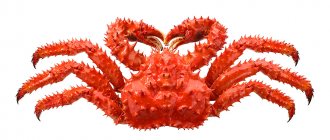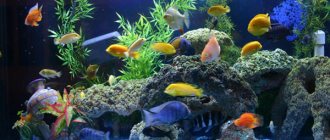General information
The rainbow crab belongs to the order Decapods. Exotic beauty has other names. Because of his strong attachment to his home, he is also called a patriot, and he received the name indigo due to the corresponding color.
Caring for crabs is quite simple, but the owner must know the basic rules of keeping them.
The rainbow crab spends most of its life on land. He needs water for breeding and during molting. Therefore, the aquaterrarium should be equipped in accordance with the needs of the pet.
In their natural habitat, rainbow crabs live in burrows up to 1 m deep. If there is no food on their territory, they can easily overcome a long distance to get to the center of the mangrove forests. They find their way home quickly.
Rainbow crab is the most popular crab that can be found at home.
Reproduction
Reproduction of crabs in captivity is very rare. Their larvae must develop in sea water. Almost all crabs on sale are caught in the wild.
Watching the rainbow crab is a pleasure. Some owners manage to tame these babies and then they themselves ask to be held and even eat from the hand.
If seen in its entirety, you can see a very durable and very hard shell that covers all parts of the body. It remains a mystery how a crab larva, several mm in size, grows and reaches such enormous sizes, because the chitinous shell is not capable of stretching or increasing in size.
It turns out that when the volume of a crab increases inside, it simply sheds its old chitin and becomes covered with a new shell. This process is called molting. Let's try to find out some features of the molting of the Kamchatka crab, as the most studied of the commercial crab species.
The life of a future giant begins with an egg. The female carries it on the underside of her abdomen for 11 months and two weeks. During spring migration, larvae emerge from the eggs. At the larval stage, five molts pass, after which the larva turns into a fry. The body of the fry is already completely similar to the body of an adult animal. If , then you can imagine what a fry looks like - a fingerling, whose size is hundreds of times smaller.
Numerous molts, and in the first year there are 11 - 12, in the second year - 7, in subsequent years - two per year, almost no one sees, because the juvenile crab leads a lifestyle hidden from prying eyes among the benthic vegetation. Of these, young crabs are selected at 7-8 years of age, when the size of their carapx is greater than 7-9 cm.
The molting of adult female eggs deserves special attention. After the juveniles emerge from the eggs, the females continue to migrate along with the males. During the time between moults, a lot of animals have settled on the shells of the females - they have stuck, empty shells dangle under their abdomens after the juveniles emerge from them, and the ladies look far from presentable. But nevertheless, males choose girlfriends and help them molt, and at the same time attach their reproductive products to their legs. During this period, when looking at a pair of Kamchatka crabs, it may seem that the male is touchingly courting his girlfriend, holding her “hands.” After about three days, the molting of the females, and with it the process of attachment of the male reproductive products, ends and the partners separate. This period is also called crab spawning. It lasts from May to August. Almost immediately after molting, fertilization of new eggs will occur, with which the females pass until next spring. Then the molted females migrate separately from the males along with the grown juveniles.
The molting of males is more important for fishing than the molting of females. So, if you buy a crab that has just molted, it will be of poor quality. In addition, individuals caught immediately after molting are subject to release into the sea, along with females and crabs that have not grown to commercial size. Correct assessment of the molting condition of males allows you to buy Kamchatka crab of good fatness.
Immediately before molting, some of the substances needed for the new coat, especially those containing calcium, are transferred to the muscles of the crab. The more well-fed the male crab was before molting, the faster his new shell hardens. The highest rate of hardening is observed in the first two weeks. If the crab had poor nutrition, the so-called empty crab, then its shell hardens much longer.
It is customary to distinguish five molting stages:
stage 0 - the state before molting, the old shell softens, water accumulates in the crab’s tissues, which increases its internal volume, the membranes between the segments also swell with excess fluid;
stage I - the new shell is completely soft;
stage II - the shell is hard, but if the crab is lifted by the large segment, it bends under its weight;
stage III - the shell is hard, there are the first scratches on the ventral side, the first animals - fouling animals - may appear on the upper side;
stage IV - the shell is hard; if you lift it by the large segment, it can withstand the weight of the animal; on the upper side you can find various hydroids and bryozoans.
It is most profitable to buy a crab at the 3rd - 4th stage of molting.
Despite the fact that males during the molting period can gather in groups and form a kind of conglomerate for protection from enemies, those individuals that fall into the center of the cluster have a better chance of surviving.
It should be said that the Kamchatka crab molts until the end of its life; it does not have a final or final molt, as, for example, in another commercial species, the snowbird opilio. Losing the old shell during molting, the Kamchatka crab has a good presentation at any age.
Rainbow crab (lat. Cardisoma armatum) is an amphibious crustacean that lives in many aquariums and home aquaterrariums. Other names for crab: indigo crab, tricolor crab, land crab, patriot crab. Perhaps its size is larger, and its body color is brighter compared to its relatives, which is why it is very popular among fans of underwater pets. As for caring for it, the animal has a finicky and capricious disposition. Lives on the Pacific coast.
An amphibian species that lives in burrows dug in the sand. During the breeding season, it moves to the ocean waters. The rest of his life is spent at his burrow, exploring the coastal area. There it also looks for food, sometimes enters the forest and returns back. Otherwise, competing crabs will occupy his house, followed by fights.
According to its morphological characteristics, the tricolor crab belongs to the order Decapoda (ten-legged crustaceans), suborder Brachyra, subfamily Grapsoides, family Geracinidae, genus Cardisoma.
Types of Rainbow Crabs
This species includes the following representatives of crustaceans:
- Atlantic ghost crab. Lives in coastal waters of the United States. When a crab's gills dry out, he must get into water to moisten them.
- Harlequin crab (or white-spotted, moon) crab. Indigenous to the mangrove forests of South America. The body length is small, only 5 cm.
- Land hermit crab. It is also called "palm thief" or "coconut crab". This representative of arthropods is the largest of all relatives. The height of an adult individual is over 40 cm, and one claw reaches 90 cm in length. With its powerful “arms” the crab can hold luggage weighing 30 kg. In nature, it can be found on the coast of the Pacific and Indian oceans.
